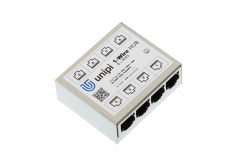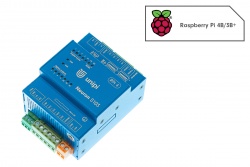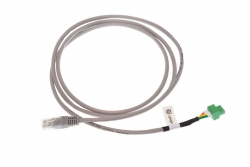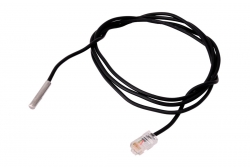
16/10/19 1-Wire bus-related products are a mainstay of Unipi product range. In this article you can learn more not only about the function and advantages of this simple and cheap communication bus, but also about the improved 1-Wire connectors on Unipi controllers
What is 1-Wire and how does it work?
1-Wire is a name for a communication bus designed by Dallas Semiconductor company, that is designed for the low-speed transmission of digital signals. As the name suggests 1-Wire sensors can theoretically use only a single conductor for both power voltage and data. The negative pole can be grounded. In practice, however, at least two conductors are used. 1-Wire sensors available in the Unipi stock then use a total of four conductors for better reliability and enhanced serialisation options.
A distinct advantage of the 1-Wire bus is the low component price; thermometers available at Unipi e-shop are offered from €10 apiece. A single bus can be up to 200 m long with up to 15 sensors connected at once. Each sensor is also provided with its own HW address for its addressing on the bus.

Installation recommendations
The 1-Wire bus is prone to electromagnetic interference, it is thus recommended to use a shielded cable (ie. FTP). The cable must be routed through places with the least interference possible and must be well clear of any cables supplying induction loads. The most frequent sources of interference are frequency converters, inverters etc.
It is also important to follow the bus topology and to avoid creating any branches. To meet this condition we recommend using Unipi 1-Wire thermometers featuring a pair of data conductors - one leading back to the PLC or the previous sensor on the bus, one leading to the following sensor in the line. On the end of the bus, a sensor must be placed to avoid any signal bounces. Communication speed is pre-defined, eg. cannot be decreased as with the RS485 interface to mitigate the interference. Any issues with the bus should be fixed only by adjusting the wiring, decreasing the number of sensors or dividing the network between multiple controllers. We are currently developing a Modbus RTU extension with eight 1-Wire ports that will be able to prevent such issues.
1-Wire bus on Unipi products
Unipi 1.1 controller, all Unipi Neuron controllers and nearly all Unipi Axon models are by default provided with a single 1-Wire port. The Unipi range of goods also includes a range of 1-Wire sensors for measuring various quantities; alternatively, you can use other 1-Wire sensors not offered by Unipi.
When combined with Neuron or Axon controllers the 1-Wire bus represents a simple and cheap method to read the temperature, humidity and other quantities, and to use them for various automation tasks. By using 1-Wire splitters or hubs you can then create extensive networks of 1-Wire sensors placed throughout the facility or house while avoiding any excessive expenses due to the low component cost of 1-Wire devices and cabling. The simple infrastructure then allows you to easily extend the network by simply adding another sensor.
Given the sensitivity towards EM interference, it is not recommended to use the 1-Wire in industrial automation. Its low cost, simplicity and wide range of compatible products makes the bus an ideal solution for smart home applications, especially when combined with the versatility and broad connectivity of Unipi controllers.
New 1-Wire connectors
Originally, both the Unipi 1.1 and the Unipi Neuron featured an RJ45 1-Wire port identical to the Ethernet port, with the range of 1-Wire sensors adapted to this solution by using corresponding RJ45 connectors. With the introduction of the Unipi Axon product line, we also introduced a new 3-wire screw terminal port offering better reliability and durability when compared to the RJ45, and after thorough tests the Unipi development team decided to use the screw terminal on Unipi Neuron controllers as well. Consequently, Neuron controllers with the RJ45 port are currently being phased out in favour of the newer model with 3-wire screw terminals and will be available only until their stocks last. That said, the 3-wire screw terminal was established as a new 1-Wire connector standard for both the Axon and the Neuron.

A 1-Wire thermometer connection scheme
Both the 1-Wire thermometers and the 8-port 1-Wire hub will retain the RJ45 connector. In order to connect those products to controllers using the new screw terminal please follow the steps below.
Connecting a single 1-Wire thermometer
In the case of a single thermometer, all you need to do is a simple modification of the connector
- cut the RJ45 connector and isolate the wires
- fasten ferrules to the wires
- following the color scheme above, screw the wires to the screw terminal connector (included in the controller's package)
Connecting a pair of 1-Wire thermometers
If you need to connect two thermometers to a single controller, purchase a corresponding variant of the 2-port splitter and connect it to your controller. After that, simply connect both thermometers using the pair of RJ45 ports.
Connecting multiple 1-Wire thermometers
To connect more than two thermometers use the 8-port 1-Wire hub. Connect the hub to your controller using the cable reduction; the reduction must be connected in the Port 1 of the hub. Then simply connect all necessary 1-Wire thermometers using all available hub ports. Bear in mind it is not possible to skip ports, as this would result in cutting off the sensor following after the skipped port from the bus. Alternatively, you can interconnect several hubs to create a centralised 1-Wire network.
For more info about the possible connections, please visit this link.








